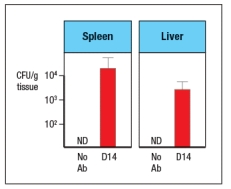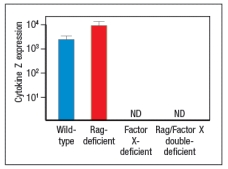Like wild-type (WT) mice, Rag-deficient mice have large numbers of commensal microbes in their gastrointestinal (GI) tract that remain contained in restricted to anatomical locations associated with the GI tract. However, when Rag-deficient mice are treated with a depleting antibody that eliminates all lymphocytes from the animals, these mice suffer from dissemination of commensal bacteria to peripheral organs, such as spleen and liver, and show evidence of systemic inflammation as shown by cytokine levels in the serum. ND, not detected; D3, day 3 post-antibody injection; D14, day 14 post-antibody injection. 
a) What are the cells in Rag-deficient mice, that, when depleted by the antibody injection, cause bacterial dissemination and systemic inflammation?
In a follow-up study, the Rag-deficient mice were treated with a blocking antibody to neutralize a cytokine (cytokine Z) known to be produced by lymphocytes. On day 14 post-antibody injection, the spleen and liver of the mice were analyzed for numbers of bacteria, and the results are shown in Figure : 
b) What is the likely identity of cytokine Z?
In a second follow-up study, Rag-deficient mice were crossed to a knockout for a transcription factor (Factor X) also known to be expressed in some lymphocytes. Lamina propria lymphocytes were isolated from wild-type mice, Rag-deficient mice, Factor-X-deficient mice, and double Rag/Factor-X deficient mice, and mRNA was prepared from the cells. RT-PCR was then used to determine the mRNA transcript levels for cytokine Z in all four lymphocyte populations, and the results are shown in Figure. 
c) What is the likely identity of Factor X?
In a final experiment, the entire small intestine of wild-type mice, Rag-deficient mice, or Factor X-deficient mice is isolated and processed for mRNA, which is then used in RT-PCR experiments. Expression levels of mRNA encoding RegIII and RegIII are assessed in these samples; the results are shown in Figure. 
d) What do these data indicate about the regulation of RegIII and RegIII expression? Which cells are expressing RegIII and RegIII ?
Correct Answer:
Verified
View Answer
Unlock this answer now
Get Access to more Verified Answers free of charge
Q17: Reovirus is an enteric virus that
Q18: In a second experiment, the isolated
Q19: Macrophages were isolated from the spleen or
Q20: Secretory IgA produced in the epithelium of
Q21: Recurrent infections with the enteric pathogen Clostridium
Q22: Wild-type mice are adoptively transferred
Q23: Oral tolerance to food antigens and immune
Q25: IL-10-deficient mice develop spontaneous colitis, a disease
Q26: When mice are born, their intestinal lamina
Q27: IPEX syndrome is a genetic disease
Unlock this Answer For Free Now!
View this answer and more for free by performing one of the following actions

Scan the QR code to install the App and get 2 free unlocks

Unlock quizzes for free by uploading documents